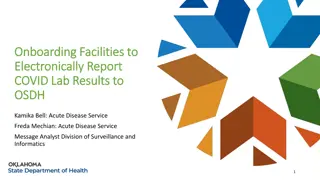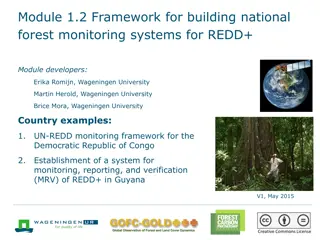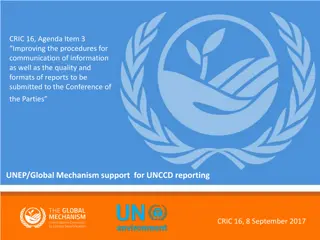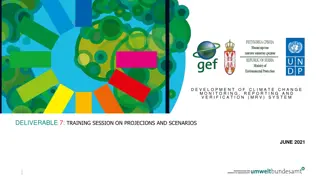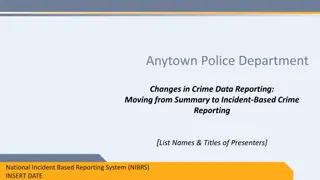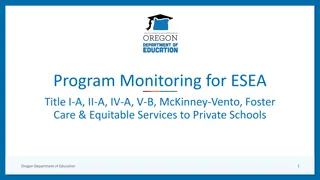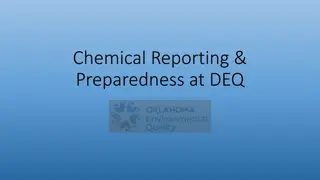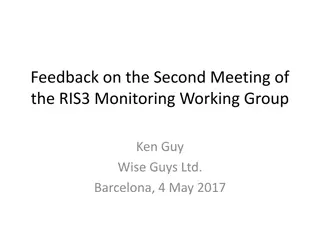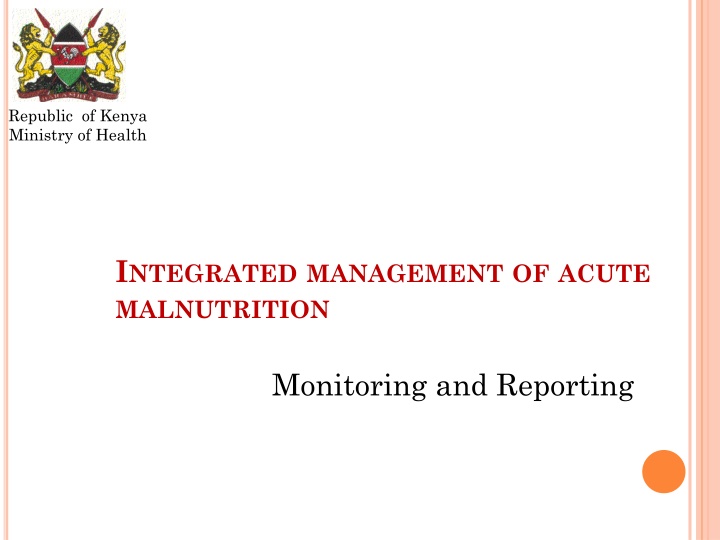
Integrated Management of Acute Malnutrition Monitoring and Reporting
Explore the Integrated Management of Acute Malnutrition Monitoring and Reporting system in Kenya's Ministry of Health. Learn about the overall objective, key learning objectives, monitoring tools, and the importance of a standardized M&R system for IMAM. Understand the significance of registration in tracking children across different health services.
Download Presentation

Please find below an Image/Link to download the presentation.
The content on the website is provided AS IS for your information and personal use only. It may not be sold, licensed, or shared on other websites without obtaining consent from the author. If you encounter any issues during the download, it is possible that the publisher has removed the file from their server.
You are allowed to download the files provided on this website for personal or commercial use, subject to the condition that they are used lawfully. All files are the property of their respective owners.
The content on the website is provided AS IS for your information and personal use only. It may not be sold, licensed, or shared on other websites without obtaining consent from the author.
E N D
Presentation Transcript
Republic of Kenya Ministry of Health INTEGRATED MANAGEMENT OF ACUTE MALNUTRITION Monitoring and Reporting
OVERALLOBJECTIVE Enable health workers to adequately monitor and evaluate IMAM activities
LEARNING OBJECTIVES: By the end of this session participants should be able to: Understand the meaning and difference between monitoring and evaluation Understand the importance of monitoring and reporting nutrition interventions Fill all reporting tools properly Gather, analyze data and compile monthly reports Understands evaluation parameters Understand how to calculate and interpret the different performance indicators
OVERVIEW Monitoring and Reporting (M&R) system is an essential component in IMAM for improving service delivery IMAM M&R system encompasses individual monitoring of admission, treatment process and outcome Monitoring is used to measure the monthly performance and report on effectiveness
Standardized M&R forms and tools are used to collect and aggregate community outreach, out- patient care, in-patient care, supplementary feeding programme monitoring data This enables data to compared across different sites as well as aggregate data at the various administrative levels
REGISTRATION Unique Nutrition Registration Number All new admissions receive one that is maintained until child is discharged, even if a child is referred to another health facility or site It helps in tracking a child across different services and for sharing of information and used on all monitoring and referral forms pertaining to the child. It can be recorded at the bottom of page 20 on the mother & child health booklet -MOH 216
REGISTRATION Unique Nutrition Registration Number The first set of numbers refers to the code of the health facility (or site) where treatment is provided The second and third set of numbers refers to the Child Welfare Clinic number allocated to the child in Section B, Page 20 of their MCH booklet. This is the child s number in the register plus the year he fourth set of letters refers to the programme component where the child entered
REGISTRATION Register Book All admissions and follow-up information on each individual admitted are recorded here: Inpatient Nutrition Care Register - MOH 368 1) Out-patient Therapeutic Care - MOH 409 2) Supplementary Feeding Programme under five - MOH 410A 3) Supplementary Feeding Programme Pregnant and Lactating Women - MOH 410B). 4)
REGISTRATION- REGISTER BOOK Inpatient Nutrition Care Register Health Facility Register MOH 368 Enter 1 in this column if client is admitted based on edema criteria (+, ++, +++) Enter 2 if client is admitted based on a WHZ criteria Enter 3 if client was admitted based on a MUAC criteria Enter 4 for OLD CASES
REGISTRATION- REGISTER BOOK Inpatient Nutrition Care Register Health Facility Register MOH 368 Type of Admission Enter 1 for New cases, 2 for Re- admission, 3 for Re-lapse, ETC Sero-status HIV status TB Status Tuberculosis status Height/Length (cm) Weight (kg) MUAC (cm) Weight (kg) / MUAC (cm) Monitoring Record the weight and MUAC of the client every seven days while in treatment in the in-patient center.
REGISTRATION- REGISTER BOOK Inpatient Nutrition Care Register Health Facility Register MOH 368 Discharge Measurements Exit Date (DD/MM/YY) Length of Stay in Days - This only applies to clients who exit the program as cured. Exit Outcome Enter 1 for Cured, 2 for Defaulter (absent for 2 days in in-patient care), 3 for Died etc Observations/Comments - Any comments for the individual client (e.g., client referred, advised to return for review).
INDIVIDUAL MONITORING Individual monitoring information of the child s health and nutrition condition is recorded on the following and is used in determining the progress of the treatment 1. Multi-Chart 2. Supplemental Suckling Technique In- patient Card Admission Card 3. Out-Patient Therapeutic Care 4. Follow-Up Card for Out-patient Therapeutic Care 5. Outpatient Ration Card 6. Supplementary Feeding Ration Card
INDIVIDUAL MONITORING- TRANSFER FORMS Transfer Form Out-Patient to In-Patient Care and In-patient to Out-Patient Care 1. 2. Transfer Form Supplementary Feeding Programme to In-patient or Out-Patient Care 3. Referral Form Community to Health Facility)
INDIVIDUAL MONITORING- TRANSFER FORMS Used to transfer a child from one programme to the other. Referrals are not new admissions Caregiver is given a transfer form together with instructions on how and when to go where If a transfer form is not available then all information regarding transfer and/or referral can be recorded in the clinical notes section on page 38 of the Mother & Child Health Booklet MOH 216
SERVICE MONITORING- MONTHLY SUMMARYSHEETS The In-Patient, OTP & SFP Facility Summary Sheet (MOH 713) is completed monthly per health facility with inputs from the registers Information is used to assess performance, monitor trends and identify areas that require investigation at the health facility level
SERVICE MONITORING- MONTHLY SUMMARYSHEETS Total number in treatment at the beginning of the month Admissions as new cases Old Admissions relapses Old Admissions readmissions (i.e., returned defaulters) Old Admissions transfer from other OTP/SC Discharge Cured Discharge Death
SERVICE MONITORING- MONTHLY SUMMARYSHEETS Discharge Defaulters Discharge Non Recovered Transfer out to SC Transfer to other OTP sites Under GFD Programme Average Length of Stay in Days Nutrition Recovery Rate, Defaulter Rate, Death Rate For the SFP Summary Sheet, the transfers in and out are referring to transfers from other SFP sites and also transfers from in-patient/OTP programmes.
SERVICE MONITORING- MONTHLY SUMMARYSHEETS Gender Tallied for all patients who enter as new admissions to identify differences in affected gender, age groups and trends Total Discharges All patients that leave the site as cured, died, defaulted or non-recovered. The number of total discharges is used as a denominator to calculate performance indicators for the cured, death, defaulter and non-recovery rates. Transfers are not part of the denominator in calculating performance.
SERVICE MONITORING- MONTHLYSUMMARY SHEETS Total Exits Number of all patients that exit the site that month and includes all patients who are discharged (as cured, died, defaulted or non- response) and who are leaving the site as transfers. Total Number in Treatment Total number in treatment at the respective site is calculated and used for site planning. It also provides the start number for the next month s tally column.
SERVICE MONITORING- MONTHLY SUMMARYSHEETS Stock Summary Report Part of the MoH 713 form. It requires the total numbers of males and females in the different components of the IMAM programme and then requires and opening stock, receipts, distributed, losses and closing stock to be registered CSB/UNIMIX in Kg, Oil in Kg, RUTF in Sachets, RUSF in Sachets, F-75 in Sachets, F-100 in Sachets Calculation is as follows: Closing stock = (Opening stock+ receipts)-(Distributed + Losses)
MONTHLY SUB-COUNTY REPORTS The sub-county reports are completed monthly with inputs from each facility via summary sheets (Moh 713) These sheets are digitally entered into the District Health Information System (DHIS) by the 15th of the following month A hard copy should be filed after they are entered into the system at this level
MONTHLY SUB-COUNTY REPORTS Aggregated reports contain performance and monitor trends at the district/sub-county level as follows: Total number in treatment at the beginning of the month Admissions as new cases (New admits) Admissions old cases (Relapse, Readmission and Transfers In) Total admissions of the month Exits (Cured, Death, Defaulter, Non-response, Transfers out) Total Exits
MONTHLY DISTRICT/SUB-COUNTY REPORTS Aggregated reports contain performance and monitor trends at the district/sub-county level as follows: Total number in treatment at the end of the month Average Length of Stay Number of individuals in programme currently in a General Food Distribution Programme Outcome (Recovery Rate, Death Rate, Defaulter Rate). Gender distribution for children 6 59 months SFP monthly reports have additional column for transfers in and transfers out
MONTHLY SUB-COUNTY REPORTS CHVs are supervised by CHEWs and collect data from the community using 1. Community Health Workers Service Delivery Log Book MOH 514 which is a diary used to collect information from the household while offering a health service and/or health messages.
MONTHLY DISTRICT/SUB-COUNTY REPORTS CHWs Service Delivery Log Book MOH 514 - Columns N , O and P Children 6 59 months old with MUAC indicating severe acute malnutrition Children 6 59 months old with MUAC indicating moderate acute malnutrition Children <5 years with malnutrition referred Record the number of children 6 59 months old with severe acute malnutrition mid-upper arm circumference is red (< 11.5 cm) N Record the number of children 6 59 months old with moderate acute malnutrition- mid- upper arm circumference is yellow (11.5 12.4 cm) Record the number of children under 5 years with severe and moderate acute malnutrition referred for management O P
MONTHLY DISTRICT/SUB-COUNTY REPORTS Community Health Information System Household Register MOH 513 is a record where CHWs record major household events Updated monthly from log book submitted to CHEW
MONTHLY DISTRICT/SUB-COUNTY REPORTS CHIS Household Register MOH 513 - Column S and T S Severely malnourished ( ) Record by marking a tick ( ) when the household child mid-upper arm circumference is red (< 11.5cm) and leave blank when the child in the household has a mid-upper arm circumference that is not red . T Moderately malnourished ( ) Record by marking a tick ( ) when the household child mid-upper arm circumference is yellow (11.5 12.4 cm) and leave blank when the child in the household has a mid-upper arm circumference that is not yellow or red.
MONTHLY DISTRICT/SUB-COUNTY REPORTS From these CHW reports, the CHEW summary MOH 515 is compiled monthly Indicators to include into CHW Reports Record the total number of children 6 59 months old identified by CHWs from the household level with severe or RED color using MUAC and referred for specialized care. Number of severe malnutrition cases referred Record the total number of children 6 59 months old identified by CHWs from the household level with Moderate or Yellow color using MUAC and referred for specialized care. Number of moderate malnutrition cases referred
MONTHLY DISTRICT/SUB-COUNTY REPORTS CHEW may collect and report on the following: Key indicators: Human resources Training Community mobilization Community outreach activities:
MONTHLY DISTRICT/SUB-COUNTY REPORTS Additional information collected to understand nutrition situation Barriers to access in IMAM services Reasons why areas are not covered Reasons for absentees and defaulting Reasons for non-response to treatment Causes of death Success stories Identified problems Planned activities The report is sent to Health Records information officer who eventually feeds it into DHIS
MONTHLY DISTRICT/SUB-COUNTY REPORTS Summary Entry and Exit Categories for Individual and Service Monitoring Inpatient Care ENTRY CATEGORIES Outpatient Care 1. New admission: New case of child 6-59 months who meets the admission criteria -- including relapse after cure 2. Other new admissions: New case: infants (<6 months), child ( 5 years), adolescent, adult who needs treatment of SAM in inpatient care 3. Referral from outpatient care: Condition of child deteriorated in outpatient care (according to action protocol) and child needs inpatient care Or Returned after defaulting (or Moved from other inpatient care site)* 1. New admission: New case of child 6-59 months who meets the admission criteria -- including relapse after cure 2. Other new admissions: New case who does not meet pre-set admission criteria but needs treatment of SAM in outpatient care (special case, based on decision of supervisor) 3. Referral from inpatient care: Case of child 6-59 months referred from inpatient care after stabilization and continues treatment in outpatient care Or Returned after defaulting (or Moved from other outpatient care site)*
MONTHLY DISTRICT/SUB-COUNTY REPORTS Summary Entry and Exit Categories for Individual and Service Monitoring Inpatient Care EXIT CATEGORIES Outpatient Care 1. Discharged cured: Child 6-59 months who meets discharge criteria, i.e., special cases that were not referred to outpatient care earlier 2. Discharged died: Child 6-59 months who dies while in inpatient care 3. Discharged defaulted: Child 6-59 months who is absent for two days 4. Discharged non-response: Child 6-59 months who remained in inpatient care does not reach discharge criteria after two weeks in treatment 5. Referred to outpatient care: Condition of child has stabilized, child s appetite has returned, complication is resolving and the child is 1. Discharged cured: Child 6-59 months who meets discharge criteria 2. Discharged died: Child 6-59 months who dies while in outpatient care 3. Discharged defaulted: Child 6-59 months who is absent for three consecutive visits 4. Discharged non-recovered: Child 6-59 months who does not reach discharge criteria after four months in treatment 5. Referred to inpatient care: Condition of child has deteriorated or child is not responding to treatment (per the action protocol), and child is referred to inpatient the medical
MONTHLY DISTRICT/SUB-COUNTY REPORTS Narrative Report: Prepared on quarterly or as needed basis Provides a summary of key information and analysis based on the quantitative data compiled at health facility level in the In-Patient, OTP & SFP Facility Summary Sheet (MOH 713) as well as the Monthly Sub-county/District Reports Submitted by the CNO to County Steering Group and the County Nutrition Technical Forum
MONTHLY DISTRICT/SUB-COUNTY REPORTS Narrative Report information: Scale of the service Key performance indicators Discussion on performance, including: Analysis of high and/or low performing sites Barriers to access Reasons for absentees, default, non-response to treatment and relapse Common causes of death
MONTHLY DISTRICT/SUB-COUNTY REPORTS Narrative Report information: Contextual information as appropriate such as food security, water and sanitation, health, and insecurity that may have an influence on service operation or performance Success stories Action plan for next month and support needed/planned to be given Quantitative information can be presented in figures if the capacity exists
PERFORMANCEINDICATORS Output indicators measure whether an IMAM service has completed the planned activities needed to achieve the established objectives. They are measured as numbers. 1. Process indicators directly measure the performance of key processes, which in this case relates to the IMAM treatment process. 2. Outcome indicators measure whether an IMAM service has achieved its objectives and planned outcomes. They are measured as percentages. 3.
PERFORMANCEINDICATORS- OUTPUT INDICATORS Monthly Total number of new admissions Total number of children and pregnant and lactating women under treatment Report on use of F75, F100, RUTF, ReSoMal and CMV, RUSF, CSB/OIL (IMAM Consumption and Requests)
PERFORMANCEINDICATORS- OUTPUT INDICATORS Health facility and District Level Number of functioning in-patient care, out-patient care sites and/or SFP sites (or number of health facilities with in-patient care, out-patient care and/or SFP sites) Number of health care workers trained in IMAM and referral based on action protocol (plus gender distribution) Number of community health extension workers and community health workers trained in community outreach (plus gender distribution)
PERFORMANCEINDICATORS- PROCESS INDICATORS Barriers to Access and Utilization identifies information on knowledge, attitudes and practice (KAP) Cause of Death: Identifies problems with treatment and use of action protocols, and determine where strengthened support, training and supervision might be needed.
PERFORMANCEINDICATORS- PROCESS INDICATORS Reasons for Absentees, Defaulting and Non- Response to Treatment: identifies common reasons for default or non-response to treatment. Reasons for non-response might include a high prevalence of TB and/or HIV, the sharing of food in the household or poor access to water and sanitation. This information might indicate a need for stronger service linkages with other sectors. Readmission after Discharge (or Relapse): to understand situations outside of the service. Interventions might be needed at the household level to avoid high readmission rates
PERFORMANCEINDICATORS- PROCESS INDICATORS Average Length of stay (LOS) of Discharged Cured The period in number of days that a child spends in treatment for SAM from admission to discharge. Normally long and can take up to 60 days, but shorter in inpatient care. One child can cover both services. Average length of stay in SFP is usually less than 3 months
PERFORMANCEINDICATORS- PROCESSINDICATORS Long average LoS can mean: - frequent absences - sharing of RUTF, undiagnosed medical condition Short average LoS can mean: - if coupled with high relapse rate, it can mean that children are being discharged too soon
PERFORMANCEINDICATORS- PROCESSINDICATORS Calculated on those discharged as Cured Average LOS =sum LOS divided by number of cards in sample
PERFORMANCEINDICATORS- PROCESSINDICATORS Average weight gain (AWG) of Discharged Cured For SAM cases in outpatient care is expected to be greater than 4 g/kg bodyweight/day A low AWG may indicate, e.g., high absence, default, ineffective treatment, sharing of RUTF and/or non- compliance to the treatment protocol Calculated on a sample of cured discharges for kwashiorkor and marasmus separately, as the sum of weight gains divided by number of cards in the sample.
PERFORMANCEINDICATORS- PROCESSINDICATORS Calculation: Daily weight gain (g/kg bodyweight/day) = [discharge weight in g minus minimum weight in g] divided by [minimum weight in kg multiplied by the number of days between minimum weight and discharge day] Average daily weight gain = sum of weight gains (g/kg bodyweight/day) divided by number of cards in sampleprotocol
PERFORMANCEINDICATORS- PROCESSINDICATORS Referral Rate Children are referred from out-patient care to inpatient care per the action protocol in outpatient care or from in- patient care to a higher level of care when their condition deteriorates or when the child is not responding to treatment Calculated for children or PLW referred from SFP to OTP or in-patient care.
PERFORMANCEINDICATORS- PROCESSINDICATORS The referral rate provides information on severity of cases that are admitted and/or non-response to treatment and hence highlights weaknesses in the care system (e.g., late presentation of cases, quality of care, endemic patterns). Calculation: Referral rate = Number of children referred per number of children in treatment during the time period of reporting
PERFORMANCEINDICATORS- OUTCOME Monthly Outcome Indicators % discharged cured (cure rate) = proportion of children discharged cured of total discharged* % discharged died (death rate) = proportion of children who died when under treatment of total discharged*
PERFORMANCEINDICATORS- OUTCOME Monthly Outcome Indicators % discharged defaulted (default rate) = proportion of children recorded as absent for third consecutive week or outpatient care session of total discharged* % discharged non-response (non-response rate) = proportion of children who do not meet the discharge criteria after four months under treatment of total discharged* *Total number of discharged = cured + died + defaulted + non-response







